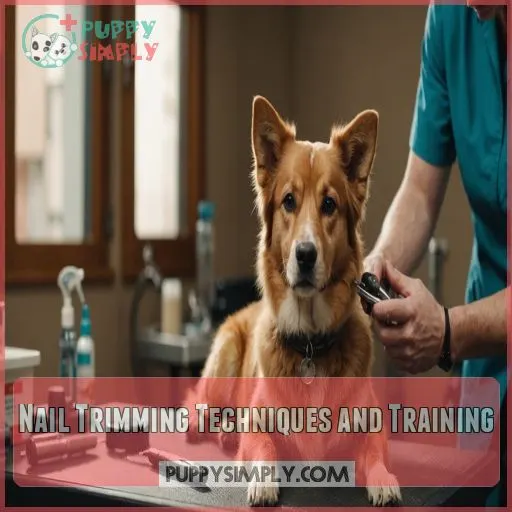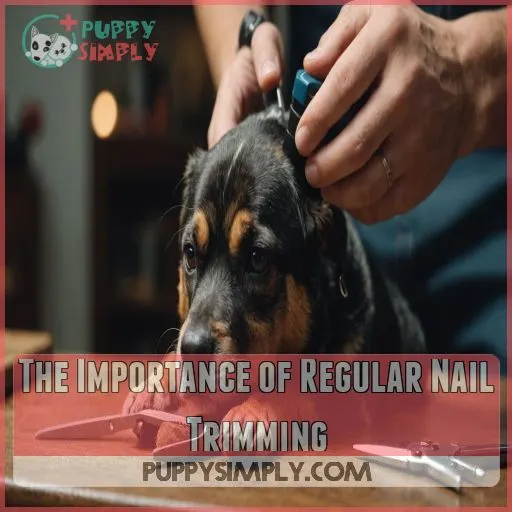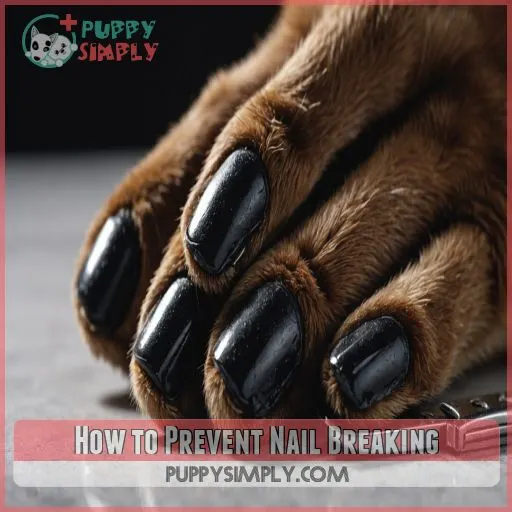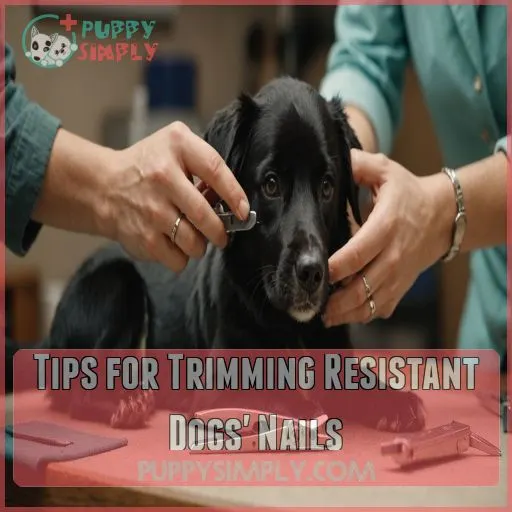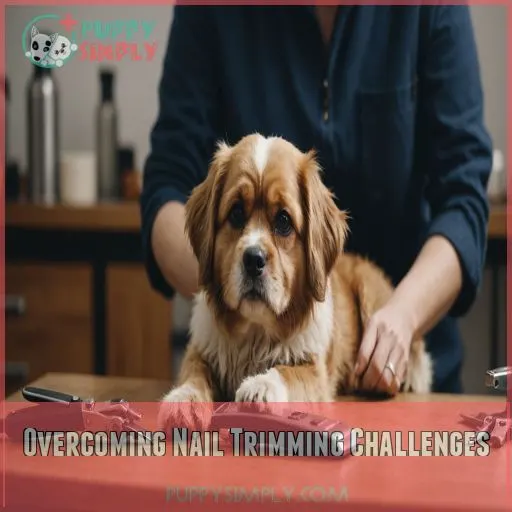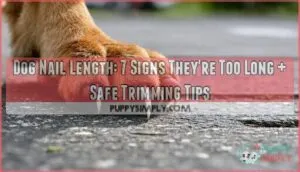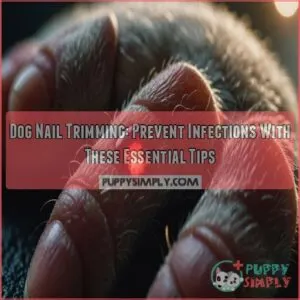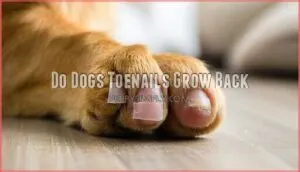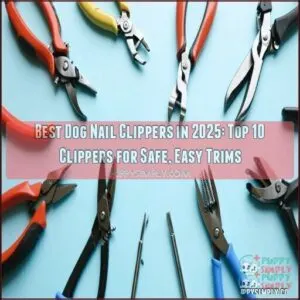This site is supported by our readers. We may earn a commission, at no cost to you, if you purchase through links.
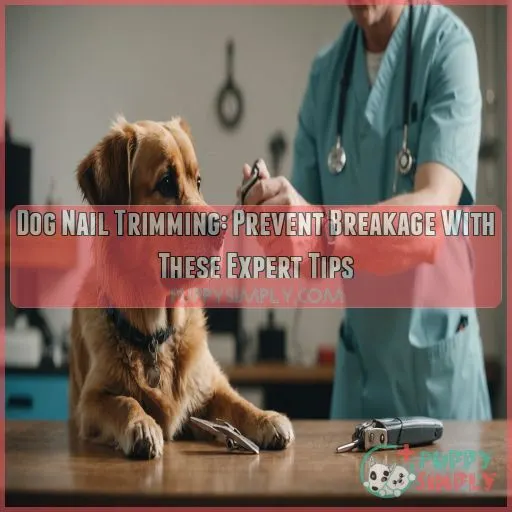
First, make sure your dog gets used to the clippers by associating them with treats and praise.
Sharp clippers give you an edge, quite literally, while soaking their paws in water softens nails, making trimming easier.
Try a Dremel for less pressure and more precision.
Regular trims are your best bet to avoid breakage—think of it as a spa day for your pup.
Stick around to discover how to make nail maintenance a walk in the park for even the fussiest hounds.
Table Of Contents
- Key Takeaways
- Nail Trimming Techniques and Training
- The Importance of Regular Nail Trimming
- How to Prevent Nail Breaking
- Tips for Trimming Resistant Dogs’ Nails
- Nutrition and Nail Health
- Overcoming Nail Trimming Challenges
- Frequently Asked Questions (FAQs)
- How to prevent dogs’ nails from breaking?
- Why are my dog’s nails split after trimming?
- Why do my dog’s nails crumble when I cut them?
- How do you trim a resistant dog’s nails?
- Why are dog nails prone to splitting?
- How often should dog nails be trimmed?
- What tools are best for dog nail care?
- Can exercise reduce nail overgrowth in dogs?
- What are signs of nail infections in dogs?
- Conclusion
Key Takeaways
- Trimming your dog’s nails regularly is like giving them a spa day; it prevents nail breaking and keeps them from tap-dancing across the floor, which can lead to discomfort and health issues related to long nail problems. Aim for trims every 2-4 weeks, and remember, it’s not just about looks – it’s essential for their health and happiness.
- Think of sharp clippers as your best tool for the job. Just like you wouldn’t mow the lawn with a rusty blade, sharp clippers (or even a trusty Dremel) give you a smooth, snag-free experience, avoiding painful splits and crumbles. Before you start, test those clippers like a chef tests a knife – it’s a game-changer.
- Soaking your dog’s paws is a nifty trick that can make nail trimming a breeze, especially when using proper trimming techniques. A warm water soak for 10-15 minutes softens the nails, reducing breakage. It’s like a bubble bath for their paws – only without the rubber duckies!
- Patience and a sprinkle of encouragement work wonders. Make nail trimming a treat-filled, praise-heavy adventure rather than a dreaded chore. Remember, patience is your best pal, and with a bit of practice, you and your pup will be strutting confidently in no time.
Nail Trimming Techniques and Training
Proper nail trimming techniques and consistent training are essential for keeping your pup’s nails healthy and preventing painful breaks.
Whether you’re working with a puppy or an older dog, a gradual, positive approach will help them feel at ease during the process.
This will also help in maintaining their overall nail health through consistent training.
Nail Trimming for Puppies
Starting puppy nail trims early can be a game-changer.
Use positive reinforcement methods and stress-free introductions to clippers. Encourage curiosity with treats and praise, making puppy grooming habits easy as pie.
This helps prevent nail breaking long-term.
Nail Trimming for Older Dogs
Nail trimming for older dogs requires patience and finesse, especially when learning how to use dog nail trimmers safely.
Gradually introduce the clippers, shower them with praise, and monitor their reactions carefully.
Like teaching a reluctant student, use positive reinforcement to increase tolerance.
Accustoming Your Dog to Nail Clippers
Introducing nail clippers doesn’t have to be a nail-biting experience!
With early exposure, create positive associations by acting chipper as you bring out the clippers and rewarding your dog with treats.
Consistency is key in building your dog’s comfort and trust.
Training Your Dog to Allow Paw Handling
Gently touch your dog’s shoulder and work your way down to their paws.
Focus on the toes, applying gentle pressure while using a soothing voice and rewarding with treats.
Patience and consistency are key to overcoming paw sensitivity.
Nail Trimming: the Final Step
You’ve mastered paw handling techniques, and now it’s showtime!
Clip a single nail, shower with praise and rewards, and repeat.
Quick avoidance tips? Steer clear of the quick!
Keep sessions short—like sprinting, not marathons—to prevent nail splitting.
The Importance of Regular Nail Trimming
Regular nail trimming isn’t just a spa day for your dog; it’s essential for their health and happiness, especially when it comes to avoiding nail breakage.
Without it, they might start clicking across the floor like a tap-dancing troupe, leading to discomfort and even serious health issues.
Preventing Broken Nails
Preventing broken nails is about proactive nail maintenance.
Softening techniques, like a good soak, and using sharp nail care tools are key.
Avoid canine anxiety by making this time rewarding, not risky. Look into Alaska Animal Hospital for biotin supplements.
Avoiding Mobility Issues
When nails grow too long, they mess with your dog’s stride, like trying to dance in shoes a size too small.
Keeping nails trim aids joint health, supports arthritis prevention, and boosts exercise routines.
Reducing Ingrown Nails
Keeping your pup’s nails in tip-top shape helps prevent them from curbing inward.
Proper trimming is a game-changer!
Remember:
- Trim Frequency: Every 2-4 weeks.
- Dremel Usage: Smooth edges.
- Correct Paw Positioning: Avoid accidents.
Side Effects of Untrimmed Nails
Untrimmed nails can wreak havoc, leading to discomfort and even pain for your furry friend.
Overgrown nail pain can become a real nail-biter, causing trauma or infections.
Here’s a quick overview:
| Issue | Result |
|---|---|
| Overgrown nail pain | Mobility hindrance |
| Untrimmed nail discomfort | Risk of infections |
| Trauma from long nails | Severe discomfort |
Keep those nails trimmed and your dog’s tail wagging!
Long-term Health Problems
Untrimmed nails can lead to painful mobility issues, ingrown nails, and joint stress.
Neglecting nail care also raises infection risk.
Don’t let overgrown nails compromise your pup’s health – stay on top of regular trims.
How to Prevent Nail Breaking
To keep your dog’s nails from breaking, you need to trim them regularly.
Using sharp clippers and a positive attitude is essential for this process.
Just like you wouldn’t try to mow the lawn with a rusty blade, make sure your nail tools are up to the task for a smooth, snag-free experience.
Trimming Nails Early and Often
Keeping your dog’s nails trim isn’t just for looks; it’s like taking your shoes to the cobbler for regular dog nail care and safe dog grooming tips to prevent nail issues.
Starting early with puppy acclimation helps.
Monitor growth and aim for early grooming, preventing issues before they start, through regular maintenance.
Using Sharp Clippers and Testing the Blade Edge
While trimming your dog’s nails, sharp clippers are essential.
Dull clippers make cutting a real pain and risk breakage.
Before use, check your clippers’ sharpness like a chef tests a knife, ensuring they’re effective and well-maintained, and making cutting less of a real pain.
Soaking Nails in Water to Soften Them
Before leaping to alternative solutions, try soaking your dog’s nails in warm water.
It helps soften them, making trimming a breeze.
Aim for about 10-15 minutes.
This gentle method can be a game-changer for fragile nails.
Considering a Dremel for Nail Trimming
Now, let’s chat about using a Dremel.
It can offer a gentler experience than clippers, especially if Fido’s into Dremel noise desensitization.
The vibration’s tolerable, like a massage for paws!
Remember Dremel safety considerations when mastering this technique.
Making Nail Trimming a Positive Experience
You can turn nail trimming into a walk in the park!
Use positive reinforcement:
- Conditioning clippers—make them your dog’s best friend.
- Create a calm environment to ease nerves.
- Reward system: treats and belly rubs for every successful snip, creating a walk in the park experience.
Tips for Trimming Resistant Dogs’ Nails
Trimming a resistant dog’s nails can be a real challenge, but with patience and the right techniques, you can make the process much smoother.
Whether you’re working with an older pup or a puppy who’s just not a fan of nail trims, these expert tips will help you overcome their fears and get those nails clipped safely with the right techniques.
Desensitizing Older Dogs to Nail Trimming
Older dogs can learn nail trims with patience.
Create a custom desensitization routine that uses non-invasive tools and subtle behavioral cues.
Adjust trim frequency as needed.
With time, you’ll nullify negative past experiences and confidently tackle those tricky claws!
Using Positive Reinforcement Techniques
Positive reinforcement is key – offer tasty treats and enthusiastic praise as you gradually accustom your pup to nail trimming.
This builds trust and makes the experience rewarding, not frightening.
- Reward calm paw handling
- Give treats during clipping
- Praise throughout the process
Gradually Introducing Nail Clippers
Getting your furry friend familiar with nail clippers starts with building trust.
Fear reduction begins with slow, initial exposure, turning it into a game.
Introduce the tools gradually, rewarding curiosity.
Patience is key; success here creates positive associations over time.
Monitoring the Dog’s Response and Adjusting
Keep a close eye on your pup’s body language.
If they seem uneasy, take a break.
Adjust your approach – try shorter sessions, more treats, or a different nail trimmer to ease their anxiety.
Avoiding Rushing the Process
In this venture of patient conditioning, remember slow and steady wins the race!
Embrace time management by using gradual exposure.
A step-by-step approach with calming techniques guarantees a stress-free experience, like gently guiding a canoe down a peaceful river.
Nutrition and Nail Health
Want your dog’s nails to be strong and healthy?
Upgrading their diet with animal-source protein, like eggs or meat, gives their nails a boost, so they can romp and play without worrying about nail splits!
Upgrading a Dog’s Diet for Healthy Nails
A balanced diet isn’t just for humans—it’s a game-changer for your dog’s nail health too.
Boosting nail strength can be as easy as adding:
- Omega fatty acids for gloss and resilience
- Protein supplements for nourishment
- Hydration impact through fresh water
- Vitamin supplementation
Animal-source Protein for Stronger Nails
Feeding your pup protein-rich foods like eggs, meat, and fish can work wonders for their nail health.
The amino acids in these ingredients promote stronger, more resilient nails.
Plus, biotin and collagen supplements may further bolster their nail strength.
Preventing Nail Splits With Regular Trimming
Don’t wait for disaster—the answer to nail trimming benefits is regular trimming.
Schedule those sessions strategically to maintain nail health.
Use reliable trimming tools and adopt split prevention strategies for happy paws.
It’s like giving your pup a spa day, without the fancy robes!
Long Walks and Regular Grooming for Healthy Nails
Your pup’s nails will stay strong and healthy with regular walks on abrasive surfaces like concrete and frequent grooming visits.
Pair this with a balanced diet rich in protein, and you’ve got the recipe for durable, damage-resistant nails. Easy peasy!
- Frequent walks on concrete
- Regular grooming appointments
- Protein-packed diet
Overcoming Nail Trimming Challenges
Overcoming nail trimming challenges with your dog might feel like a circus act, but with patience and positive techniques, even the most anxious pup can become a nail-trimming champion.
Learn when it’s time to call in the professionals and how to transform this chore into a stress-free experience for both you and your furry friend.
Helping Dogs Overcome Fear of Nail Trimming
Switching gears from nutrition to behavior, helping your pup overcome nail trimming fear is like teaching them to love rainy walks.
Use positive reinforcement and desensitization techniques, ensuring gradual exposure with each session.
A bit like building their confidence over small steps, it’s all about anxiety reduction.
Soon, they’ll view nail trims as just another chance for treats and cuddles, making the experience a chance for treats!
When to Seek Veterinary Help for Nail Trimming
If your pup’s nail trimming feels trickier than a Rubik’s Cube, it might be time for some extra help.
Severe nail injuries or chronic nail conditions warrant a vet visit. Extreme anxiety? No problem! Vets have sedation options to ease the process.
If complications arise, don’t wing it. Professional assistance guarantees your dog stays happy, healthy, and free from nail trouble, ensuring they remain happy, healthy.
Making Nail Trimming a Stress-free Experience
Creating a calm environment for nail trimming is like setting the stage for a perfect play. Gently handle your dog’s paws, using treats and calm commands as your script.
A regular routine helps them feel safe.
Just like practice makes perfect in mastering a musical instrument, frequent sessions build confidence.
Who knew trimming nails could be as soothing as a spa day?
Frequently Asked Questions (FAQs)
How to prevent dogs’ nails from breaking?
Regular nail trimming keeps your dog’s nails in tip-top shape, preventing breaking.
Aim for every 2-4 weeks.
Try soaking paws pre-cut for softening, and a nourishing diet can help build strong, healthy nails too.
Why are my dog’s nails split after trimming?
Ever wonder why your dog’s nails split after trimming?
It could be that you’re using dull clippers or cutting too close to the quick.
Don’t worry – with the right technique, you can prevent those painful splits.
Why do my dog’s nails crumble when I cut them?
Your dog’s nails might crumble if they’re too dry or brittle.
Try soaking them before trimming or improve nail health with a balanced diet rich in animal proteins.
Also, make sure your clippers are sharp!
How do you trim a resistant dog’s nails?
Tackling a dog’s nails can feel like wrestling a bear, but patience is key!
Introduce clippers gradually, associate them with treats, and trim just a nail or two per session to make sure a calm experience.
Why are dog nails prone to splitting?
Dog nails can split like dry twigs when they’re too long or brittle.
Regular trimming and good nutrition—especially with enough animal protein—keep them healthy.
Think of it as the secret handshake to robust canine nails!
How often should dog nails be trimmed?
Trimming those nails every 2-4 weeks is a must, partner!
Letting them grow wild is a recipe for disaster – we’re talking painful splits, mobility issues, and even nasty infections.
Stay on top of it, and your pup will be strutting tall!
What tools are best for dog nail care?
Don’t skimp on tools for dog nail care!
Invest in sharp clippers or a trusty Dremel.
They’re like magic wands for paws, transforming nail trimming from dreaded chore to simple routine.
Your furry friend will thank you!
Can exercise reduce nail overgrowth in dogs?
Regular exercise definitely helps reduce nail overgrowth by naturally wearing down the nail during activities like walking on abrasive surfaces, like concrete.
Just make sure you don’t overdo it to prevent injury.
What are signs of nail infections in dogs?
Your dog’s nail infection might show signs like redness, swelling, or discharge around the nail bed.
Fido’s licking paws more than usual or limping? Don’t brush it off—they might need a vet’s visit.
Conclusion
Admittedly, dog nail trimming can seem intimidating, but with the right techniques and a positive mindset, it’s a breeze when using the right dog nail clippers.
Establish a routine, use the proper tools, and make it an enjoyable bonding experience for your pup.
Embrace this essential grooming task, and you’ll both be strutting with confidence in no time, and it will make for a great bonding experience.

